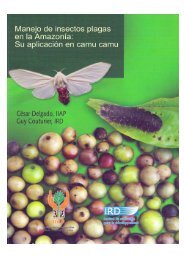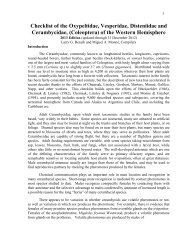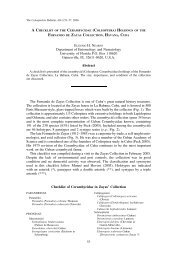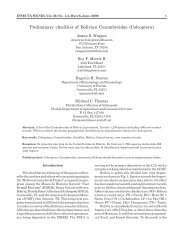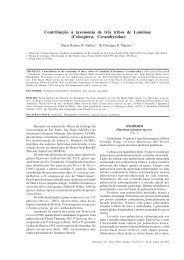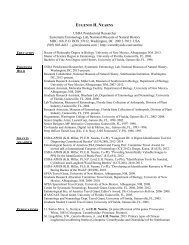You also want an ePaper? Increase the reach of your titles
YUMPU automatically turns print PDFs into web optimized ePapers that Google loves.
LAWRENCE S. DILLON <strong>AND</strong> ELIZABETH S. DILLON 101<br />
apical one slightly sinuate medially, basal oblique laterally; disk with three tubercles,<br />
median one elongate, narrow, 110t reaching to apex, the others placed one<br />
on each side, broad, rounded, feebly elevated. Scutellum transverse. Elytra with<br />
sides straight, slightly narrowed to apices, which are separately rounded; disk with<br />
feeble, elongate gibbosities basally, coarsely, rather closely punctate, without granules,<br />
more finely so apically; humeri prominent, angle not tuberculate but from it a<br />
short carina extends posteriorly. Prosternum simple, nurrow, widened from middle<br />
to b:le; mesosternum deeply cmarginate at apex. Legs rather short; procoxae<br />
globose, in m:lle anteriorly feebly tuberculnte; femora clavate, profemora rugose<br />
basally in male; metatibiae expanded moderately to apex in male. Antennae<br />
slightly Jonger than body in male, slightly shorter than body in femllle, slender;<br />
sea.pe gradually clavate, lower surface not (or feebly) arcuate; third segment onethird<br />
longer than scape, feebly sinuate; fourth slightly shorter than sc.ape.<br />
GENOTYPE.-HypselonLus syrinx Bates, herewith designated. Selected<br />
as it is the species most frequently encountered and was<br />
listed by Thomson along with Plerodia singularis, Plerodia spuria,<br />
and Plerodi{t pygrnea in his original description of the genus without<br />
designation of the type.<br />
KEy TO SPECIES<br />
1. Elytrll. with yellowish confluent mllcultlC arranged in evcr:ll iines extending their<br />
full length, more distinct posteriorly ........................... variegata.<br />
Elytra without colored lines extending their full lengt.h . . . . . . . . . .. . . . . . . .. . 2.<br />
2. Elytra with a rather distinct oblique vittn. from humerus to suture at apical<br />
one-third, thence indistinct . . . . . . . . . . . . . . . . . . . . . . . . . . . . . . . . . . . . . . 8yrinx.<br />
Elytrn with oblique vitta obsolete or wanting ...................... 8ingulari8.<br />
Plel'odia syrinx Bates<br />
PLATE V, PJGURE 7.<br />
fiYP8elofllw BtlrillX Bates, Ann. Mag. Nat. Hist.., (3), XVI, 1865, p. 170.<br />
Ilypsioma syringa Bates, idem.<br />
Plerodia syrinx Bates. Thomson, Physis, Il, 1868, p. 61.<br />
Plerodia pygmea Thomson, Physis, II, 1868, p. 61.<br />
Distinguished by the antennal horn of male being longer than<br />
in other species; elytral oblique vitta rather distinct, extending indistinctly<br />
to apex, and pl'onotum conical, discal tubercles well elevated.<br />
MALE. Elongate-ovate, robust, subcylindrical, elytra subconvex; bead and<br />
pronotum piceous, elytra paler. Head above thinly yellowish-gray pubescent, vaguely<br />
and irregularly mottled with brown ; front dark brown pubescent, with a. few<br />
indistinct, yellowish-gray maculae. Pronotum with mottled yellowish-gray and brown<br />
pubescence, an indistinct vitta each side laterally which is prolonged shortly onto



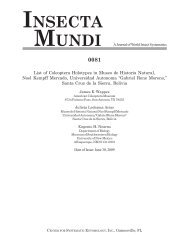
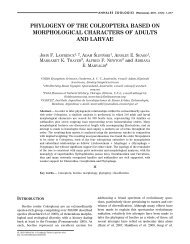


![Coleoptera. Vol. I. [Longicornia. Part I.]](https://img.yumpu.com/41202793/1/180x260/coleoptera-vol-i-longicornia-part-i.jpg?quality=85)
